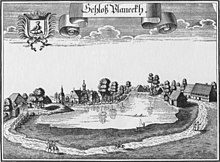Planegg Castle
The Schloss Planegg is the seat of the Lords of the former Hofmark Planegg few kilometers south-west of Munich . The former moated castle is still owned by the last von Hirsch family .
history
Planegg was first mentioned in 1409 when Duke Wilhelm III. von Bayern , the owner of the estate at the time , acquired further properties and united them with Planegg.
William III. raised the estate to Hofmark and gave it to his son Konrad von Egenhofen in 1425. When the last male descendant of Egenhofen died in 1472, Planegg passed through marriage to Christoph Lung. The noble family Lung, whose original name was Dietoch, came from the area of Rottenburg an der Laaber . The Lungs were owners for several generations until 1613, then for three years Planegg belonged to Karl von Villinger from the baronial family of Villinger von Schönenberg .
In 1616 Hans Georg von Hörwarth the Elder became lord of the castle of Planegg through purchase. The fourth generation, Johann Josef Anton Franz von Hörwarth, had to sell the property due to debts in 1732 to Johann Baptist von Ruffini (also Rufin or Ruffin) from South Tyrol, who already owned the neighboring Hofmark Krailling .
Together with other court brands, the third sold the Ruffini Planegg to the Bavarian State Minister of the Interior , Count Friedrich Karl von Thürheim . He owned it for eight years before he sold it to the Bavarian court banker Jakob von Hirsch in 1815 .
During the Reichskristallnacht from November 9th to 10th, 1938, the castle of Rudolf von Hirsch, of Jewish descent, was set on fire by SS men in civilian clothes. Since the approaching volunteer fire brigade was prevented from extinguishing at gunpoint, several rooms burned out.
Castle complex
Probably around 1415-1420 Planegg was expanded into a fortress . In 1617 the complex was expanded considerably, and the St. Magdalena Palace Chapel has also been occupied since then . On the copper engraving by Michael Wening from around 1701, a multi-structured building with an onion dome can be seen. The core of the tower is likely to come from the Middle Ages and is Planegg's landmark in the Rococo style.
In 1737 Planegg Castle was expanded and received its current baroque appearance. On the north side, the wooden tower was replaced by a new one by Gabriel von Seidl in 1818 ; this tower no longer exists today.
The castle park is traversed by the Würm and was initially laid out in the French style . After 1800 it was largely redesigned as an English landscape park. The park is not open to the public.
Castle brewery
The former castle brewery from 1835 adjoins the park. In 1850 Jakob von Hirsch renovated a brewery that had existed since the 16th century. They repeatedly changed owners and names (1886 Brewery Josef von Hirsch , 1908 Freiherrlich of Hirschsche Brewery, 1922 Schloßbrauerei Planegg Emil Freiherr von Hirsch, 1928 Schloßbrauerei Planegg AG, 1931 Pschorrbräu AG Abt. Schloßbrauerei Planegg) and was last at Munich Paulaner Brewery leased . Today the building is used as a warehouse for the Bavarian State Library .
literature
- Georg Paula , Timm Weski: District of Munich (= Bavarian State Office for Monument Preservation [Hrsg.]: Monuments in Bavaria . Volume I.17 ). Karl M. Lipp Verlag, Munich 1997, ISBN 3-87490-576-4 , p. 224 f .
- Lilian Harlander: "... a perfect brewery is close to perfection." The von Hirsch family and their castle brewery in Planegg near Munich. In: Lilian Harlander, Bernhard Purin (ed.): Beer is the wine of this country. Jewish brewing stories , Volk Verlag, Munich 2016, ISBN 978-3-86222-211-7 , pp. 71-93.
- Franz Oßner: History of the Parish Planegg , 1981.
swell
The Planegg Palace Archive is on deposit in the Munich State Archive.
Web links
Coordinates: 48 ° 6 ′ 7 ″ N , 11 ° 25 ′ 20 ″ E





